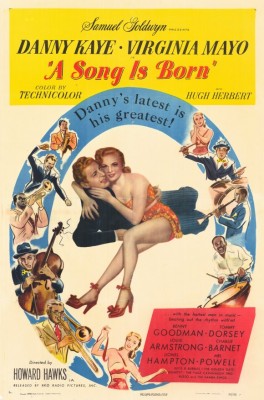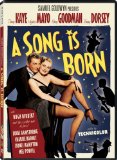| Reviews & Columns |
|
Reviews DVD TV on DVD Blu-ray 4K UHD International DVDs In Theaters Reviews by Studio Video Games Features Collector Series DVDs Easter Egg Database Interviews DVD Talk Radio Feature Articles Columns Anime Talk DVD Savant Horror DVDs The M.O.D. Squad Art House HD Talk Silent DVD
|
DVD Talk Forum |
|
|
| Resources |
|
DVD Price Search Customer Service #'s RCE Info Links |
|
Columns
|
|
|
Song Is Born, A
Though overall a lesser film, A Song is Born is notable for bringing together some of "the coolest men in jazz," as the ads truthfully promised, including Louis Armstrong, Lionel Hampton, Mel Powell, Charlie Barnett, Tommy Dorsey, and Benny Goodman, among many others. Not only do they get a lot of screentime and the opportunity to interact with one another, their performances are captured in glorious Technicolor by cinematographer Gregg Toland.
Loosely suggested by Snow White and Seven Dwarfs, A Song Is Born follows a group of bookish, isolated academics all living together for years in a large house compiling an encyclopedia on the history of music. In a chance discussion about music with two window washers (Ford L. Buck and the great John W. Bubbles, billed here - and above the title - as Buck and Bubbles), Professors Frisbee (Danny Kaye), Magenbruch (Benny Goodman), Twingle (Hugh Herbert), Elfini (J. Edward Bromberg), Gerkikoff (Felix Bressart), Traumer (Ludwig Stössel), and Oddly (O.Z. Whitehead) suddenly realize they have been cooped up for so long they've missed entirely the birth of newer forms of popular jazz: swing, bebop, jive, etc.
Frisbee ventures out to investigate, impressively enlisting the services of Tommy Dorsey, Benny Carter, The Page Cavanaugh Trio, Louis Armstrong, Lionel Hampton, and many others. In the film's best scenes, as a group they discuss the origins and variations of jazz, and jam together. The whole thing borders on the surreal, because while most of the musicians play themselves, others play fictional characters in the film. Most prominent among these is Benny Goodman; in one funny scene a clarinetist is needed and when Professor Magenbruch (Goodman) offers to sit in, the others initially doubt his ability (comparing him to Benny Goodman, no less) only to be awestruck once he starts playing.
The film's plot mucks things up somewhat. A gangster's moll, nightclub singer Honey Swanson (Virginia Mayo) is on the lam trying to dodge a subpoena that would force her to testify against her gangster boyfriend, Tony Crow (Steve Cochran). She hides out with Frisbee and his colleagues on the pretense to help them with their research, and plays along when Frisbee falls in love with her, though pretty soon she's in love with him as well.
In Ball of Fire, Kaye's part was played by Gary Cooper, cast against type, while the girl was played by Barbara Stanwyck. Cooper and Stanwyck are infinitely more memorable than Kaye and Mayo for several reasons. For one thing, it's a lot more fun watching handsome, viral Cooper play such a milquetoast, bookish character; Kaye on the other hand is soft-spoken to the point of hamstringing his métier - rubber-faced comedy and tongue-twisting songs. In A Song Is Born Kaye has no real numbers of his own, and pretty much plays straight man to all the comedy swirling around him.
Mayo, on the other hand, is beautiful and perfectly competent but no match for Stanwyck, the epitome of tough-talking dames and peerless among screwball comediennes. Mayo is undeniably more voluptuous but Stanwyck wins hands down.
Possibly hampering Mayo's performance is, presumably at Hawks's insistence, in remaking Ball of Fire so closely many of Stanwyck's line readings and specific hand gestures and the way they're filmed are repeated precisely by Mayo for A Song is Born. Mary Field, as Miss Totten, the beleagured benefactor of the professors' research grants, plays the same part in both films but she seems to be the only actor reprising a performance from the first film.
This is almost a surprise, because even some of the actors cast in A Song Is Born resemble the actors who played them in the first film. Watching A Song Is Born, I thought I recognized Kathleen Howard playing the professors' housekeeper, Miss Bragg; Howard is maybe best remembered for playing the shrewish wife of several of W.C. Fields's best films. However, it turns out that Miss Bragg is played by Esther Dale, another busy character actress who resembles Howard - but Howard herself did play the same part in Ball of Fire. Similarities extend to the costumes - Mayo's racy nightclub outfit is much like Stanwyck's, and the sets of the professors' house looks like the ones in the original film - and it could be the original, standing set as the films were made only a few years apart.
Video & Audio
As with the concurrently-released three-strip Technicolor The Goldwyn Follies and It's a Pleasure, A Song Is Born has been almost flawlessly transferred. The image is sharp and bright and the colors at times pop off the screen. The Dolby Digital English mono audio is fine; it's too bad all the jazz wasn't preserved in stereo. The disc offers alternate audio tracks in Spanish and French, and subtitles in Spanish and English (including song lyrics) but has no Extra Features.
Parting Thoughts
Jazz aficionados will enjoy seeing so many big names all jamming together, and in three-strip Technicolor no less. It's not one of Danny Kaye's better films for Goldwyn, though it's a sincere effort, and there's a certain fascination watching Howard Hawks remake a film he directed only a few years before, and remake it so closely. Overall, it's Recommended.
Film historian Stuart Galbraith IV's latest book, Japanese Cinema, is due in stores this June, and on sale now.
|
| Popular Reviews |
| Sponsored Links |
|
|
| Sponsored Links |
|
|
| Release List | Reviews | Shop | Newsletter | Forum | DVD Giveaways | Blu-Ray | Advertise |
|
Copyright 2024 DVDTalk.com All Rights Reserved. Legal Info, Privacy Policy, Terms of Use,
Manage Preferences,
Your Privacy Choices | |||||||
















